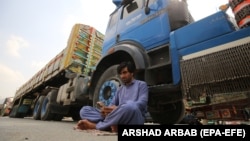
Welcome to The Azadi Briefing, an RFE/RL newsletter that unpacks the key issues in Afghanistan. To subscribe, click here.
I'm Abubakar Siddique, a senior correspondent at RFE/RL's Radio Azadi. Here's what I've been tracking and what I'm keeping an eye on in the days ahead.
The Key Issue
Pakistani border guards and Afghan Taliban fighters exchanged fire on September 6, the latest flare-up along the disputed border. Both sides accused each other of starting the firefight.
In response, Islamabad has closed a key crossing, leaving hundreds of trucks and thousands of people on both sides of the border stranded.
On the same day as the border clashes erupted, the Pakistani military said four soldiers had been killed in clashes with militants in the northwestern Chitral district, which borders eastern Afghanistan.
The Tehrik-e Taliban Pakistan (TTP) extremist group, which is believed to be based in Afghanistan, said in a September 6 statement that a large number of its fighters had entered Chitral.
In response, Islamabad called on the Afghan Taliban to rein in the TTP, which has close organizational and ideological ties with the Afghan militant group.
Why It's Important: The border clashes have highlighted the deteriorating relations between Pakistan and the Afghan Taliban, longtime allies that have fallen out over the Afghan militant group’s alleged support to the TTP.
The Taliban takeover of Afghanistan in 2021 has bolstered the TTP, which has intensified its attacks against Pakistani security forces. Peace talks held last year between Pakistan and the TTP, which were mediated by the Afghan Taliban, failed to end the violence.
The location of the TTP’s latest attack in Pakistan is also significant. Chitral, located in the remote north of Pakistan, has been a relatively stable area that has not witnessed major militant activity. The TTP’s attacks there suggest the militants could be trying to open a new front in their war against Islamabad.
What's Next: More border clashes and closures are expected as relations between Pakistan and the Taliban continue to deteriorate.
The Afghan Taliban is unlikely to crack down or expel the TTP. If the TTP continues its attacks inside Pakistan, Islamabad could resort to military action inside Afghanistan. Such a scenario would likely escalate tensions even further.
What To Keep An Eye On
The UN's World Food Program (WFP) said a “massive funding shortage” has forced it to cut emergency assistance to 2 million Afghans.
The WFP says it will only be able to provide food aid to 3 million people -- out of a population of around 40 million -- starting in October.
“Amid already worrying levels of hunger and malnutrition, we are obliged to choose between the hungry and the starving, leaving millions of families scrambling for their next meal," Hsiao-Wei Lee, WFP's country director and representative in Afghanistan, said in a statement on September 5.
The WFP is seeking an additional $1 billion over the next six months to provide 21 million Afghans with lifesaving aid. The UN body estimates that more than 3 million Afghans are on the brink of starvation.
Why It's Important: Cuts in emergency aid are likely to further worsen the devastating humanitarian crisis in Afghanistan, the worst in the world. It is also likely to add to fears of a widespread famine in the country.
In June, the UN revised its annual aid budget for Afghanistan from $4.6 billion to $3.2 billion this year, citing reduced funding from international donors.
The cash-strapped Taliban government, which is unrecognized and under international sanctions, appears unable to fill the gap.
That's all from me for now. Don't forget to send me any questions, comments, or tips that you have.
Until next time,
Abubakar Siddique
If you enjoyed this briefing and don't want to miss the next edition, subscribe here. It will be sent to your inbox every Friday.




